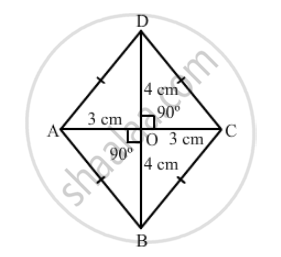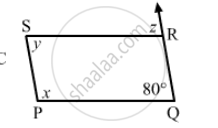Advertisements
Advertisements
Question
The diagonals of a quadrilateral are of lengths 6 cm and 8 cm. If the diagonals bisect each other at right angles, what is the length of each side of the quadrilateral?
Solution

\[\text{ Let the given quadrilateral be ABCD in which diagonals AC is equal to 6 cm and BD is equal to 8 cm }. \]
\[\text{ Also, it is given that the diagonals bisect each other at right angle, at point O }. \]
\[ \therefore AO = OC = \frac{1}{2}AC = 3 cm\]
\[\text{ Also }, OB = OD = \frac{1}{2}BD = 4 cm\]
\[\text{ In right }\bigtriangleup AOB: \]
\[ {AB}^2 = {OA}^2 + {OB}^2 \]
\[ \Rightarrow {AB}^2 = (9 + 16) {cm}^2 \]
\[ \Rightarrow {AB}^2 = 25 {cm}^2 \]
\[ \Rightarrow AB = 5 cm\]
\[\text{ Thus, the length of each side of the quadrilateral is 5 cm } . \]
\[\]
APPEARS IN
RELATED QUESTIONS
The following figure is parallelogram. Find the degree values of the unknown x, y, z.

The following figure is parallelogram. Find the degree value of the unknown x, y, z.

If an angle of a parallelogram is two-third of its adjacent angle, find the angles of the parallelogram.
Points E and F lie on diagonal AC of a parallelogram ABCD such that AE = CF. What type of quadrilateral is BFDE?
Fill in the blank, in the following, so as to make the statement true:
The diagonals of a rhombus ...... each other at ...... angles.
The diagonals of a quadrilateral are perpendicular to each other. Is such a quadrilateral always a rhombus? If your answer is 'No', draw a figure to justify your answer.
If the diagonals of a rhombus are 12 cm and 16cm, find the length of each side.
State with reason whether the following statement is ‘true’ or ‘false’.
Every rhombus is a rectangle.
The lengths of the diagonals of a Rhombus are 12 cm and 16 cm. Find the side of the rhombus
If the diagonal of a rhombus are equal, then the rhombus is a
